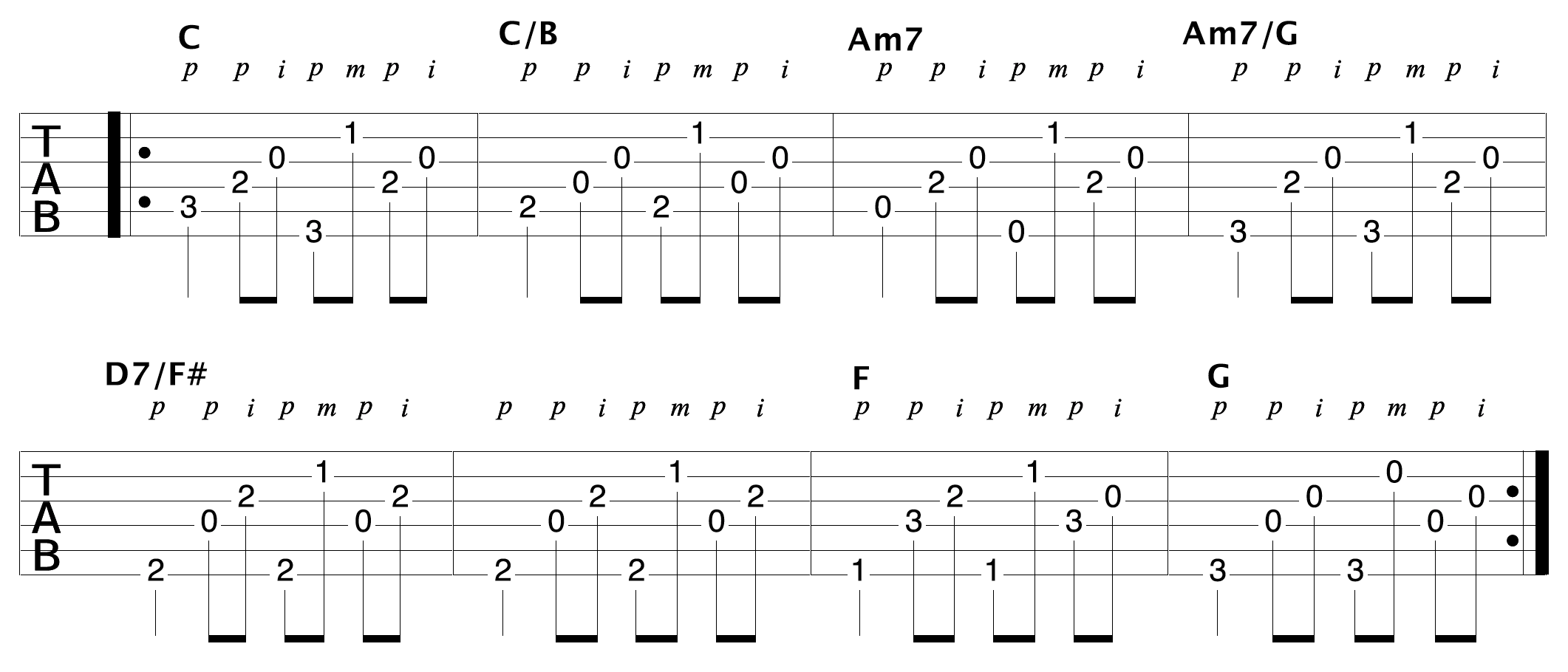Today's lesson is all about fingerpicking patterns, or more specifically one particular pattern that can be used over and over again in many, many different playing situations.
In an earlier article I showed you exactly how to develop a great fingerpicking technique (link to article here). If you haven’t read that article yet, and seen the accompanying video, and you are new to fingerpicking, then I highly recommend you do that first.
There are many patterns you can use in the world of fingerpicking, and today I want to show you one of the more useful and applicable patterns for fingerpicking your guitar.
This particular fingerpicking pattern can be known via several names. Some like to refer to it as Travis picking, while others call it the clawhammer technique.
It’s actually neither in the strictest sense. It certainly has elements of Travis picking, and the clawhammer refers to a specific banjo technique, that’s similar but not the same.
I don’t really care what you call it to be honest, it’s just a really useful fingerpicking pattern that you will be able to apply again and again to your guitar playing, much like common strumming patterns you may know.
I will refer to this pattern for fingerpicking as the clawhammer, as this is what it is generally referred to as.
Once you have the basics of this pattern down, you will find it easy to create lots of variations, further extending its use and possibilities in your own guitar playing.
This particular guitar fingerpicking pattern can be heard in thousands of songs such as “Landslide” (Fleetwood Mac), "Dust In The Wind" (Kansas), "The Boxer" (Simon & Garfunkel) and many more.
So let’s get straight to it.
Your reference point throughout when playing this fingerpicking pattern is the bass, as it consistently falls on the down beat (1, 2, 3, 4 etc), and is played with the thumb of your picking hand.
So if we take a C open chord for example, and apply the bass component of the clawhammer fingerpicking pattern in isolation, it looks like this:

In the example above I am simply alternating between the root of the chord on the 5th string (C) and the 3rd of the chord on the 4th string (E) with my thumb picking each note throughout.
Once we have the bass down, we simply add combinations of higher notes/strings in-between the bass hits, on the off beats. Here is one very common pattern, again using a C open chord:

Notice the bass part has not changed. It remains on the beat, alternating between the 5th and 4th strings while my fingers play combinations of the 2nd and 3rd strings of the chord on the off beats.
This in essence is the clawhammer fingerpicking pattern.
It’s that simple!
We can take this a step further, however by creating a variation in the bass. The previous pattern we used is what is sometimes referred to as a 5 4 5 4 pattern. This is in reference to the bass strings and the order in which they are plucked. The following is known as a 5 4 6 4 pattern, as we are now going to add more movement by bringing the 6th string into our bass, like so:

And here is our 5 4 6 4 bass with the higher strings of the chord added in as per the first example:

Either of these bass patterns are fine to use. Sometimes one will suit the situation over another. Take your time with the 5 4 6 4 pattern as it is a little more work for your thumb.
From here you can take the clawhammer fingerpicking pattern and apply it to any chord you like. You just need to adjust it to fit the chord in question.
So for example, if I was to apply this pattern to a G chord, I would need to start it from the 6th string because this is where the root note of a G chord is (You want to always start the bass pattern from the root note of the chord to which it is being applied).
So I could apply my clawhammer pattern to the G chord with a 6 4 6 4 bass.
First, here is the bass in isolation:

And the complete pattern:

Or I could use a 6 4 5 4 bass pattern, again in reference to the order in which my thumb is plucking the lower strings of the chord.
Here is the bass pattern in isolation:

And the complete pattern:

Once you have worked through the clawhammer fingerpicking pattern above on isolated chords, your next step is to apply the pattern to a progression. And not just one progression, but many, over and over so it becomes part of your guitar playing. Here is one such example to get you started:

In the example above I am using some slash chords to create nice voice leading in the bass of my chords. This is the subject for a whole other lesson, however coupled with our fingerpicking pattern we get a really nice sound!
Don’t stop here though. This is just the beginning! Take the ideas you have learned in this lesson today and apply them over and over again. This is the key to making the clawhammer fingerpicking pattern part of your guitar playing.
Learn these super advanced sounding, easy to play fingerpicking patterns for your guitar playing.
Specializing in online acoustic guitar lessons, Simon Candy is based in Melbourne, Australia where he runs his own guitar school.